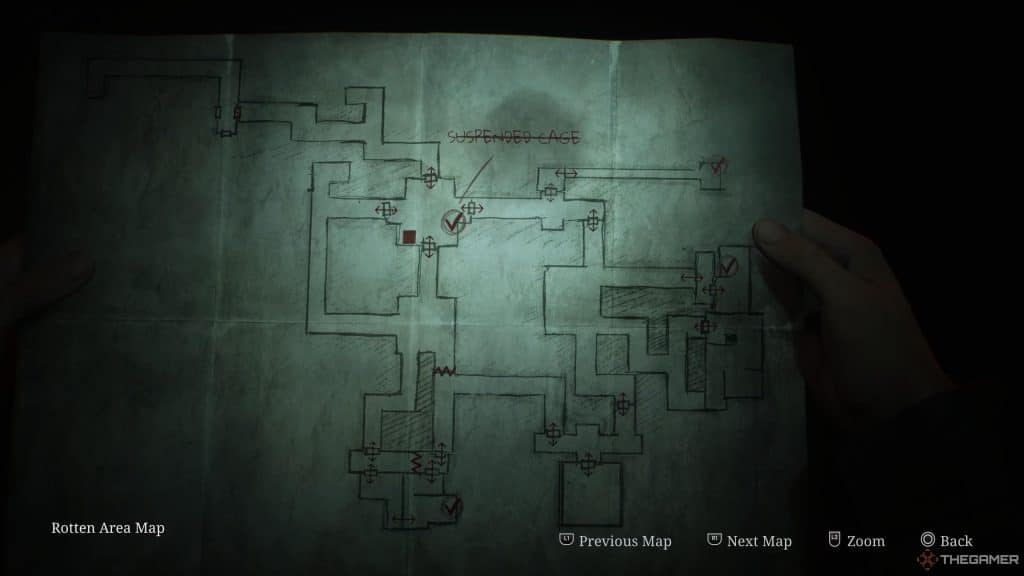Scary video game locations are often featured across multiple titles regardless of genre and audience – with some even appearing in surprising releases. Whether it’s an eerily quiet locale with suspiciously little-to-no activity, or a shockingly different-looking/themed area that doesn’t properly fit the game’s established aesthetic, such places often instill a sense of dread both subtle (having an uncanny veneer of “normality”) and unsubtle (being completely warped/visceral in appearance).
10. Body Weapon (Shinobi III: RotNM, 1993)
Greatly sticking out in an otherwise ninja-focused action title with some modern/futuristic elements mixed in here and there, the “Body Weapon” stage from Shinobi III: Return of the Ninja Master tasks players with traversing a creepy bio-engineering facility crawling with extremely gross and messy-looking mutations. Of major note is Body Weapon’s latter section: now completely overgrown with a fleshy, Akira-esque biomass, players will be doggedly attacked by a colossal bio-mutant from the background (and then face-to-face as the stage’s end boss).
9. Sandopolis Zone (Sonic & Knuckles, 1994)
This is admittedly cheating somewhat since it’s more of a stressful video game location than a “scary” one, but I still have panicked memories of trying make it to the end of Act 2 of Sonic & Knuckles‘ Sandopolis Zone before the ghost-like enemies started becoming aggressive and swarming my selected character in the dark. Made worse if one is playing as Knuckles (since the ghosts activate right at the start of the act). This section of the game adds a secondary “timer” in the form of the stage’s lights gradually growing dimmer if special switches aren’t regularly pulled.
8. The Cave of the Past (EarthBound, 1995)
As discussed in my previous article, the primarily upbeat and quirky EarthBound actually has something of a darker side: near the end of the game, the young heroes need to travel to the very distant past to defeat Giygas (the elusive main antagonist) – however, they must have their consciousnesses placed into robotic bodies to survive the trip. The heroes’ ultimate destination is a completely barren, monochrome landscape punctuated with an unsettling loop of music called “The Place” (confirmed to be a distorted sample of “Deirdre”).
7. Underground Laboratory (Resident Evil, 1996)
In the last leg of the original Resident Evil, players will gain access to what might be the game’s creepiest location seen yet: an underground laboratory facility that stands in stark contrast to the comparatively mundane-looking mansion and guard dormitory. The laboratory – quiet, dingy, and (if one is playing the 2002 GameCube remake) poorly-lit – is obviously the epicenter of many cruel and highly unethical experiments instigating the game’s premise: also known for providing minor character backstory that would pay off with the introduction of Ada Wong in Resident Evil 2.
6. Lake Jyun Sub-Gate (Mega Man Legends, 1998)
Once again, this brings up one of my all-time favorite PS1 video games. A core part of the Mega Man Legends sub-series involves the exploration of massive underground facilities for various treasures and other key items needed to progress the main story – which are guarded by aggressive and bizarre-looking automatons called “Reaverbots.” However, a notably more complex structure (called a “sub-gate”) located under a lake has a nasty surprise in store: a model of Reaverbots that can render themselves invisible, stealthily ambushing and attacking players with ferocious precision.
5. The Moon (TLoZ: Majora’s Mask, 2000)

Despite the Zelda series not lacking scary video game locations at this point (with the notorious Shadow Temple being featured just two years prior in Ocarina of Time), the immediate sequel, Majora’s Mask, brought with it an even gloomier and more surreal atmosphere across the entire game. Prior to the final boss, players will find themselves transported inside a malevolent “moon” threatening to crash down from the sky – yet the “interior” is shown as an eerily serene, quiet, and (somehow) sunny field with a giant tree surrounded by five mysterious children wearing masks.
4. The Labyrinth (Silent Hill 2, 2001)
While it’d be much easier to classify the entire titular town as a scary video game location, the so-called “labyrinth” area of Silent Hill 2 is a dreadful mixture of uncanny liminality and architectural dissonance that serves as a similar but different take on “Nowhere” (the previous game’s final location). Appearing to be a vast network of hallways from a modern house in some places and an ancient system of sewer tunnels in others, it could be argued that the area itself is more unnerving than the monster encounters due to the oppressive “wrongness” that permeates the environment.
3. Arsenal Gear (MGS2: Sons of Liberty, 2001)
Serving as the final explorable area in Metal Gear Solid 2: Sons of Liberty, Arsenal Gear is revealed to be both a global data processing center and a nuclear-armed warship with utterly bizarre internal structures that don’t seem to be logically interconnected or spatially possible. Arsenal Gear’s (strangely anatomy-themed) interior has a notably more advanced technological aesthetic that almost suggests a simulated or virtually augmented space – only raising further questions.
2. The Hospital (Little Nightmares II, 2021)
Abandoned hospitals are such an evergreen choice for scary video game locations (as exemplified by almost every Silent Hill title featuring one at some point), with the second entry in the horror-themed Little Nightmares platformer series having one of its own. Poorly lit and in an obvious state of disrepair, this tricky area contains what is arguably one of the most intense and terrifying obstacles between both games: having to play a twisted variation of “red light, green light” with packs of homicidal mannequins by keeping them at bay with your (small and inefficient) flashlight.
1. The Eternal Cities (Elden Ring, 2022)

Venturing deeper into the underground sections of FromSoftware’s Elden Ring will eventually lead players into massive locations referred to as the “Eternal Cities” in the game’s extensive lore: Nokron, Nokstella, and a nameless locale in the Deeproot Depths that appears to have been decimated. While all three cities contain very strange and disturbing sights, I personally find Nokron and Nokstella to be the most unsettling areas due to how well-preserved and majestic they are despite being incalculably ancient and seemingly all but abandoned (the ambience certainly not helping).


